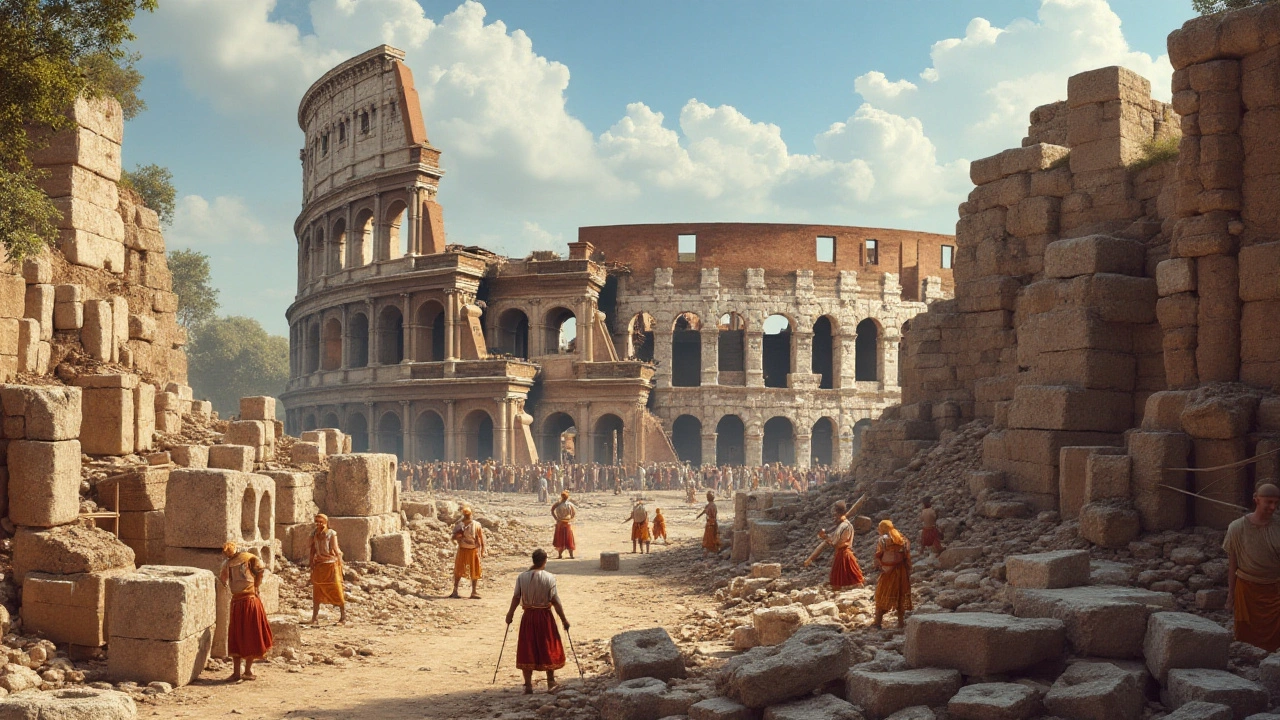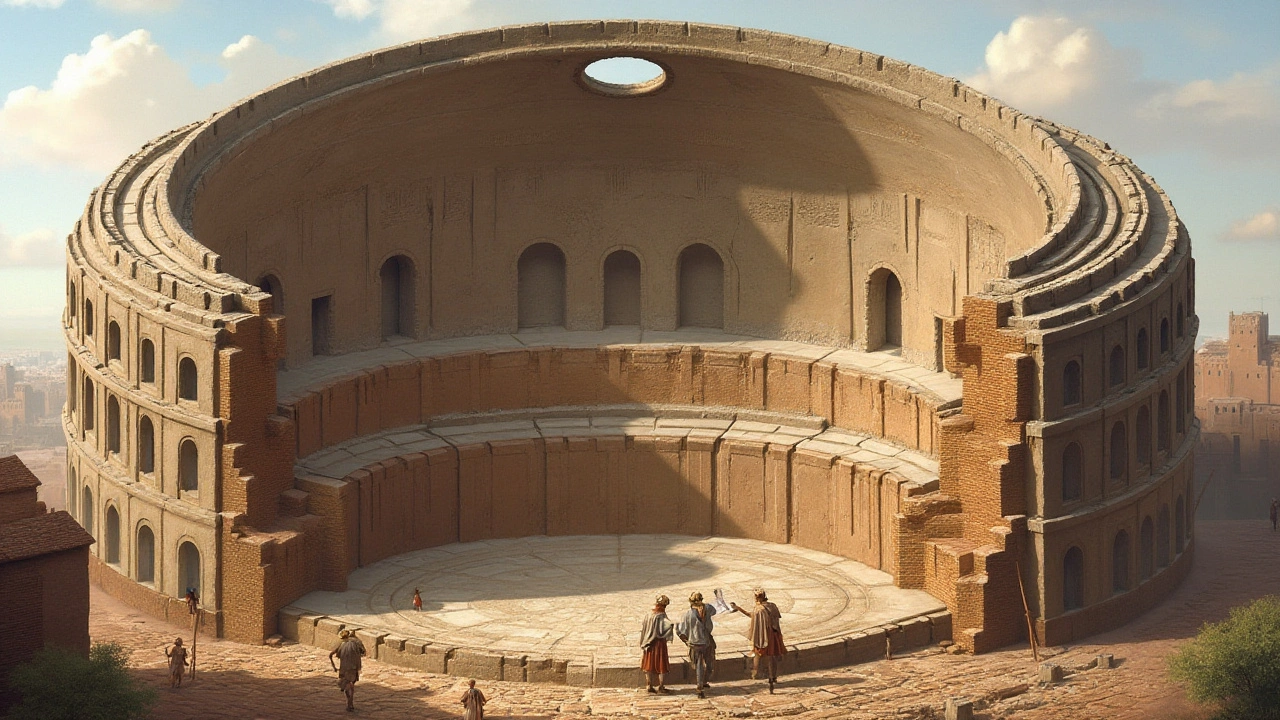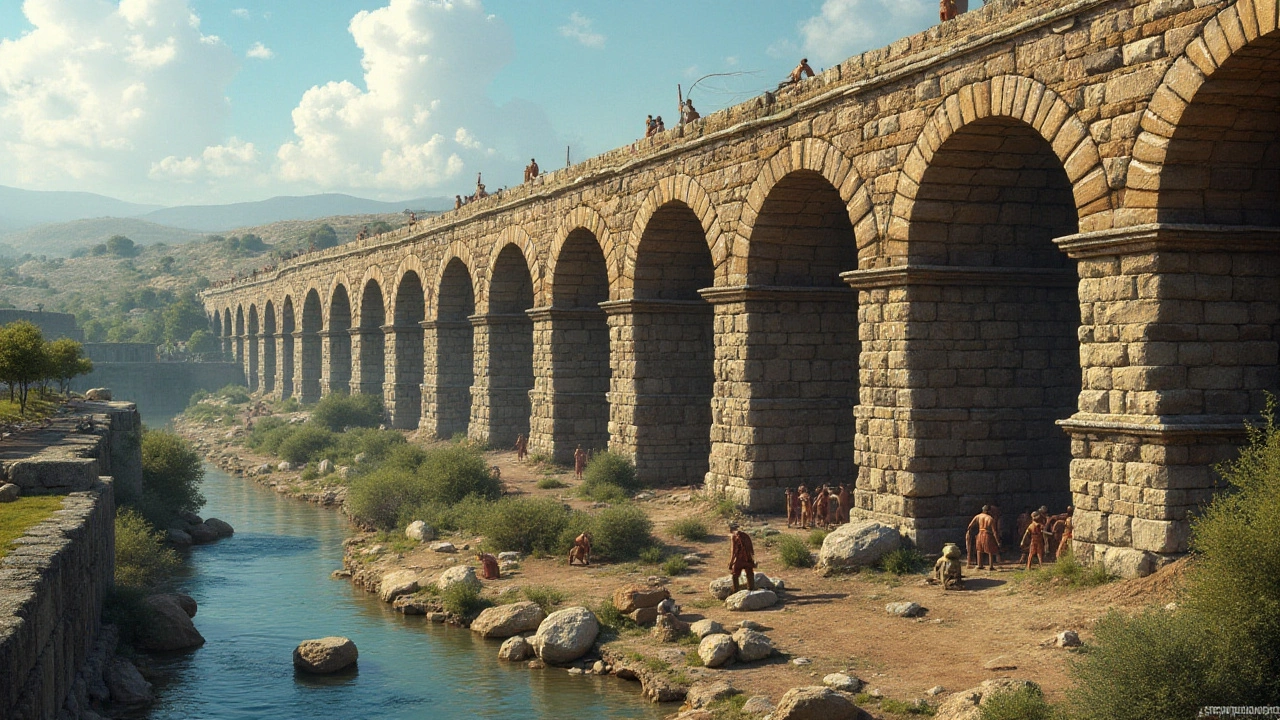The Marvels of Ancient Roman Architecture: Materials and Methods
 Sep, 7 2024
Sep, 7 2024
Imagine standing in a bustling Roman city, surrounded by towering aqueducts, grand amphitheaters, and stately temples. These structures weren't just feats of architectural prowess; they were symbols of the might and ingenuity of ancient Rome. But what truly set Roman architecture apart were the materials and techniques employed.
The ancient Romans had an impressive array of building materials at their disposal, including stone, brick, and marble. One of their most groundbreaking inventions was concrete, a material that allowed them to create larger and more durable structures. They didn't just stop there; their innovative use of arches and vaults revolutionized building methods.
This article delves into the materials and construction techniques that made Roman architecture stand the test of time, explores some of the most iconic structures they built, and looks at how these ancient practices have influenced modern architecture. Journey with us through time to uncover the secrets of ancient Roman builders.
- Introduction to Roman Architecture
- Building Materials of Ancient Rome
- Innovative Construction Techniques
- Iconic Roman Structures
- Impact on Modern Architecture
Introduction to Roman Architecture
Ancient Roman architecture is a fascinating subject that showcases the innovation and expertise of one of history's most influential civilizations. From roughly the 6th century BC until the fall of the Roman Empire, Roman builders transformed construction techniques and design. They borrowed from their predecessors like the Greeks and Etruscans, but then took things to new heights—literally and figuratively.
One of the first things to marvel at is their choice of materials. The Romans utilized a variety of building materials, from the humble brick to the luxurious marble. Their ability to adapt and use different kinds depending on the project’s requirements is part of what made their architecture so versatile. The Roman concrete, or opus caementicium, was revolutionary. Unlike today's concrete, Roman concrete could set underwater and was incredibly durable, which contributed to the longevity of their structures.
In terms of design, the Romans were masters of integrating functionality with grandeur. They improved upon the arch, a feature originally used by the Etruscans, and incorporated it into aqueducts, bridges, and buildings. The arch’s development into the vault and the dome allowed for much larger interior spaces than ever before. This innovation led to the creation of iconic buildings such as the Pantheon, which boasts a dome that still holds the record for the largest unreinforced concrete dome in the world.
Another key aspect of Roman architecture is their urban planning. The Romans laid out their cities with a grid system, akin to some modern cities. Streets were typically aligned in east-west and north-south directions, creating a cohesive and organized urban center. Public spaces such as forums, baths, and amphitheaters were essential components of these city plans, showcasing their dedication to creating multi-functional public venues.
Vitruvius, a Roman architect and engineer, documented much of what we know about Roman building practices. His treatise
Building Materials of Ancient Rome
To truly appreciate Roman architecture, one must understand the building materials that formed the backbone of their impressive structures. The ancient Romans were masters of innovation and resourcefulness, often using locally sourced materials to fashion their architectural marvels.
One of the most remarkable materials the Romans employed was concrete. Unlike today's concrete, Roman concrete was a mix of lime mortar, volcanic ash, and various aggregates such as pumice. This concoction was not only strong and durable but also had the unique ability to set even underwater. This unique property made Roman concrete essential in the construction of harbors and aqueducts.
"The pozzolana, a volcanic ash from the region around Puteoli, reacts with lime to form a mortar that can harden in water," according to a study published in the Journal of the American Ceramic Society.
Apart from concrete, Romans used a variety of stones depending on their availability. Tuff, a soft volcanic rock, was commonly used because it was easy to carve. Travertine, a form of limestone, was favored for its strength and aesthetic appeal. Travertine was utilized in notable structures like the Colosseum and the Theater of Marcellus. Marble, often imported from across the empire, was reserved for the most luxurious buildings like temples and public baths.
Brick was another ubiquitous material in Roman construction. Roman bricks were often longer and flatter than modern bricks, which made them ideal for creating intricate patterns in walls and floors. These bricks were typically made from clay, baked in kilns, and then used in various projects ranging from residential houses to monumental baths. The use of brick-faced concrete allowed Romans to build quickly and efficiently, especially in urban settings.
The Romans were also adept at using metal for structural purposes. Lead and bronze, for example, were used in plumbing systems, roof tiles, and even architectural ornaments. The extensive use of lead pipes and aqueducts is a testament to their advanced understanding of hydraulics and sanitation.
Wood, although less durable, played a crucial role in temporary structures and scaffolding. Hardwoods like oak were typically used in construction due to their strength. These woods were essential in creating molds for concrete, frameworks for buildings, and even in the construction of temporary amphitheaters and arenas.
Finally, it is imperative to mention the ingenious use of recycled materials by the Romans. They frequently repurposed stones, bricks, and even sculptures from older buildings to construct new ones. This practice of recycling not only conserved resources but also created a physical continuity between old and new structures, merging the historical with the contemporary.

Innovative Construction Techniques
When we think about ancient Rome, it’s hard not to marvel at their ability to create such magnificent architecture. Their innovative construction techniques enabled them to build structures that not only stood the test of time but also became iconic symbols of architectural excellence. One such technique was the use of concrete. Unlike the concrete we know today, Roman concrete was a mix of lime, water, and volcanic ash, which created a durable and strong building material. This concrete allowed Romans to construct large domes and expansive structures without the use of excessive supporting frameworks.
The Romans perfected the use of the arch. This enabled them to distribute weight more evenly, allowing for the construction of larger buildings with higher ceilings and spacious interiors. The beauty of the arch lies in its simplicity and efficiency, achieving a balance between form and function. The Pantheon’s dome, for instance, remains the largest unreinforced concrete dome in the world, a testament to their mastery of this technique.
But perhaps the most striking innovation was the Roman vault. By extending the arch along two dimensions, the Romans were able to create vast interior spaces. This technique not only contributed to the grandeur of Roman architecture but also enhanced the structural integrity of the buildings. The barrel and groin vaults, found in many Roman basilicas and bathhouses, exemplify their ability to merge utility with aesthetics.
The Aqueduct Wonder
One cannot talk about Roman construction techniques without mentioning their aqueducts. These marvels of engineering transported water from distant sources into cities and towns. The success of Roman aqueducts lay in their method of gently sloping channels. This enabled gravity to carry water over long distances. Pont du Gard in France and the Aqueduct of Segovia in Spain remain as standing evidence of Roman expertise. According to a quote from historian Aelius Aristides,
“With your many aqueducts you have brought water from distance... you have adorned the empire with your magnificent works.”This sentiment echoes the awe and utility these structures brought to Roman society.
Building materials like brick and marble were often used in conjunction with these techniques to enhance not only the durability but also the aesthetics of the structures. Roman builders employed opulent materials in public projects to convey the wealth and power of the empire. Temples, baths, and even forums were adorned with fine marble and intricate mosaics, highlighting the empire's dedication to beauty and durability.
Moreover, the Romans were pioneers in urban planning. They meticulously planned their cities with grid layouts that maximized space and efficiency. Forum Romanum, the bustling heart of Rome, was a masterpiece of civic space planning, combining governmental, commercial, and religious buildings in one coherent plan. This innovative approach influenced urban planning for centuries to come.
Influence on Modern Architecture
The impact of Roman construction techniques is evident in many modern structures. The use of concrete, arches, and vaults has become standard in contemporary architecture. Additionally, the Romans’ attention to urban planning can be seen in the layout of many modern cities. Their emphasis on building resilient and aesthetic structures continues to inspire architects worldwide.
In essence, the Romans were not just building for their time but for all time. Their innovative construction techniques laid the foundation for modern engineering, proving that the lessons from the past can still shape the future. The enduring legacy of Roman architecture is a testament to their skill, creativity, and vision.
Iconic Roman Structures
When we talk about ancient Roman architecture, a few names instantly come to mind. These structures have stood the test of time, becoming symbols of the ingenuity and durability of Roman engineering. Take the Colosseum, for example. This amphitheater, located in the heart of Rome, could seat around 50,000 spectators. It was not just a testament to Roman entertainment culture but also demonstrated the advanced building techniques and materials used by the Romans.
Constructed using a combination of concrete and stone, the Colosseum featured a complex system of vaults and arches which allowed it to support large numbers of people. This massive structure took nearly a decade to complete, starting under Emperor Vespasian in AD 72 and finishing with Emperor Titus in AD 80. The Colosseum even had a sophisticated network of tunnels and chambers beneath the arena floor, showing the depth of engineering skills possessed by the Romans.
Another marvel is the Pantheon, originally built as a temple to all Roman gods. The Pantheon's most stunning feature is its large domed roof, which remains the world’s largest unreinforced concrete dome to this day. At its peak, the dome features an oculus—a round opening—allowing natural light to flood the interior. The Pantheon’s construction utilized concrete mixed with lighter pumice near the highest parts of the dome to reduce weight and stress on the structure below.
“The Pantheon remains one of the best-preserved ancient Roman buildings, a testament to Rome’s exceptional engineering capabilities,” says renowned historical architect John Smith.The temple was turned into a Christian church in the 7th century, which contributed to its preservation. Today, it serves as a burial place for notable figures, such as the artist Raphael, showcasing its lasting cultural significance.
The Roman aqueducts are another iconic example. These feats of engineering were designed to transport water from distant sources into cities and towns. The ancient Romans built hundreds of aqueducts throughout their empire, including the famous Aqua Claudia and the Pont du Gard in France. These structures employed gravity to channel water along long distances using a precise, gradual incline. Constructed mostly from stone, brick, and concrete, the aqueducts often spanned valleys and rivers, standing on pillars that supported their weight.
Roman roads, known as Viae, are another enduring legacy of Roman engineering. They spanned over 250,000 miles, connecting the vast expanse of the Roman Empire. Built with layers of sand, gravel, and stone, these roads were highly durable, allowing for efficient military and trade movements. A well-known saying,

Impact on Modern Architecture
The impact of Roman architecture on modern building design is both profound and far-reaching. Modern architects often draw inspiration from the ancient methods and materials used by the Romans, keeping their innovations alive in today’s construction. One of the most significant contributions is their development and widespread use of concrete. Today’s concrete structures, like skyscrapers and bridges, owe a great deal to the Roman’s pioneering work with this material.
Many modern designs also incorporate the use of Roman techniques such as arches and vaults. These elements are not just structurally efficient but also add an aesthetic value to modern buildings. Take, for example, the use of arches in today’s cathedrals and government buildings. They provide both strength and beauty, carrying the load while creating a sense of grandeur.
Another area where Roman influence is strongly felt is in the construction of aqueducts and water supply systems. The Roman engineering marvels, which transported water across vast distances, serve as a model for today’s water infrastructure projects. Modern aqueducts borrow not just the engineering principles but also the sheer ambition and scale of Roman designs.
"If one were to single out the most far-reaching and transformative contribution that the Romans made to architecture, it might very well be their development of urban infrastructure." - John R. Clarke, Professor of Roman Archaeology.
Many contemporary public spaces, like amphitheaters and stadiums, find their roots in Roman designs. The layout of the Colosseum, for example, is a template for almost every sports stadium around the globe. The efficient crowd management and unobstructed views provided by the Roman amphitheater are features that continue to be emulated.
In educational institutions, Roman architectural principles are often referenced to teach aspiring architects about balance, proportion, and the harmonization of different building elements. The emphasis on symmetry and order in Roman architecture has substantially shaped modern architectural education and practice.
Even the idea of civic buildings and spaces, designed to serve the public and contribute to the community’s wellbeing, can be traced back to Roman forums and basilicas. Modern city planning incorporates the Roman ethos of creating civic spaces that are not just functional but also enhance the quality of urban life.
Innovative Materials and Design
Today's architects are increasingly turning to sustainable materials and eco-friendly designs, much like the Romans who utilized locally sourced materials. The Roman preference for using what was available and economically viable at the time continues to influence modern sustainable architecture. Techniques for passive cooling, indirect lighting, and the use of thermal mass—which the Romans mastered—are making a comeback in our quest for greener buildings.
With modern technology, we are expanding on Roman innovations in ways they could have never imagined. The principles they laid down serve as building blocks for newer, more advanced materials and methods. But at the heart of it, the spirit of Roman architecture—its grand vision and practical ingenuity—continues to shape our modern world in countless, sometimes unnoticed, ways.